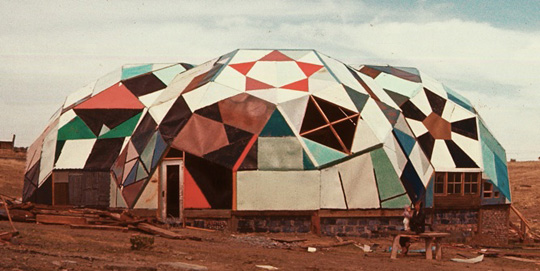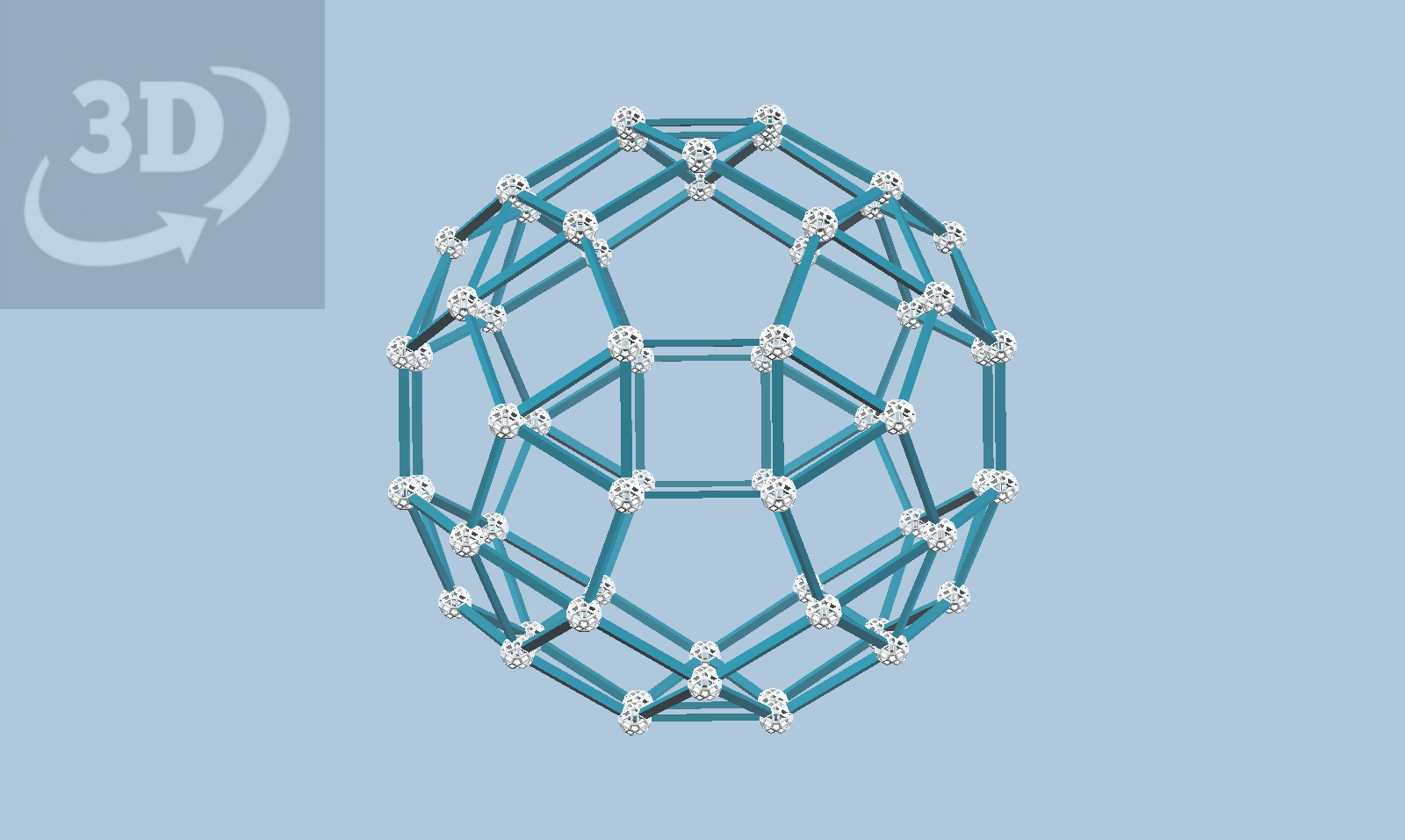In the mid-1960s, Steve Baer was involved with Drop City, an artist's community outside of Trinidad, Colorado. Baer was very interested in dome structures, but was frustrated with some of the features of geodesic domes popularized by Buckminster Fuller. Baer wanted something more adaptable, extensible, and modular, so he explored the geometry of zonohedra, polyhedra with rings of parallel edges.
Through his studies, Baer became intimately familiar with the Platonic and Archimedean solids. At Drop City, Baer and others built a variety of dome buildings "on the cheap", salvaging car tops for the panels in the domes. The most iconic of these was Baer's triple dome, constructed with parts of three rhombicosidodecahedra fused together. For brevity, I'll use "RID" instead of "rhombicosidodecahedron" (or "RIDs" plural) in the rest of this article.
Most of the figures in this article are interactive 3D views. Use your mouse or touch to rotate, pan, and zoom.
To construct his triple dome, Baer had to overcome a slight problem: when he tried to fit the three RIDs around a point, they didn't connect. The construction requires chopping off two caps from each polyhedron, exposing partial decagon faces. The problem is that the angle between those faces is not 2𝜋/3, required if they are to all meet around a point. You can try to build three such modules in Zometool, but they won't join up with normal Zome balls -- you would need two kinds of special connectors at the boundary, and you're still left with an angular gap. Baer had to "fudge" it, using force to close the slight gap the third joint.
Baer's son José recently shared with me an unpublished essay by Steve Baer himself, in which he describes this gap and the dismay that it caused him:
I was so enthralled by these forms, I assumed they were merely clumsy bubbles. Only later did I realize that these polyhedral bubbles did not fit. The fusing angles were not a perfect 120° as with the soap bubbles, but irrational angles of 116.56505°. This was cause for grief, betrayal by nature, by geometry. This was new for me. An uneven student, I was alternately excited and discouraged by science and mathematics, yet I had not encountered such disappointment in private investigations.
—Steve Baer, RID -- a love story
The 4D Approach
In four dimensions, where the three RIDs can each be in their own 3D space (hyperplane), they join seamlessly if those three hyperplanes are at the appropriate angles. In fact, there is a uniform 4D polytope that has exactly this configuration. This polytope contains dodecahedral cells (seen here in a cutaway view for clarity) that are separated by prisms and tetrahedra. This effectively wraps the dodecahedra in overlapping RIDs.
We are seeing the usual Zometool projection from 4D to 3D, so any cluster of RIDs we see here can be built with Zometool, or with an equivalent system scaled up for architectural use. To replicate the three-fold symmetry of Baer's triple dome, we can use a triple RID cluster as seen here. Let's discard the rest of the 4D polytope for a clearer view.
In terms of simplicity of construction, this approach looks quite favorable at first glance. There are only three kinds of struts needed, and only seven kinds of panel. However, things get a little more subtle when we try to define a floor plane. The symmetries of our squashed RIDs do not provide a natural place to introduce the floor. Any choice we make will require very non-standard struts and panels where our structure meets the floor.
More Symmetry
How can we mitigate this problem? One way is to choose another projection from 4D to 3D, one that naturally produces a more symmetric cluster of three RID cells. This projection (again shown in cutaway view) is the most symmetric one possible, with the dodecahedral cells symmetrically arranged around a central three-fold axis. This is still the same 4D polytope, so we get our cluster of three RIDs as before.
Since this projection has a central plane of mirror symmetry, it is easy to find a good candidate for the floor plane, with only six struts actually intersecting the floor plan rather than ending at it. The final design Needs only some half-length yellow struts, and even the central pole (and downspout!) length is easy to construct.
Unfortunately, we are paying a price for this symmetry. Our parts inventory has ballooned, with seven kinds of struts and at least nine kinds of panels! Furthermore, this design really calls for strut connectors that have three-fold prismatic symmetry, rather than full icosahedral symmetry like Zometool balls, if we want to simplify our strut designs.
A Compromise Solution
We can get back to the comfortable and familiar territory of Zometool parts, while still having a simple floor design, if we reconsider the original projection and give up on three-fold rotational symmetry. By selecting the central RID and two neighbors, we once again have a mirror plane that slices exactly through the center of the cluster. Now we can place our floor in a natural way, without introducing anything more exotic that a half-blue strut. Our parts inventory is otherwise back to just three Zometool struts and the familiar Zomeball connector, although we now require 10 different panel shapes due to the asymmetry.
Conclusion
As with anything else, perfection turns out to be elusive, and tradeoffs are always required. Nonetheless, we have at least found three ways to construct variations on Baer's triple dome without compromising on exact positions... without fudging!
I met Steve Baer in person in February of this year. He has since passed away, sadly. Before he passed, José Baer showed my initial version of this essay to his father. Steve apparently responded with, "Well, now we have to build it!" I hope my explorations gave him some joy, and perhaps a little closure.
Click on highlights in the text to show figures.
Some are interactive 3D views; use your mouse or touch to rotate, pan, and zoom.

